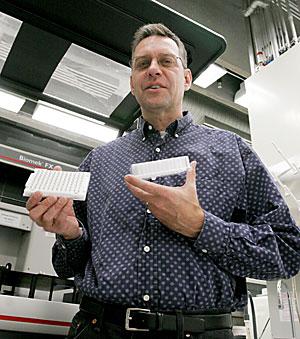 |
|
Claire C. Laurence/Arizona Daily Wildcat
|
Rod Wing, director of rice genetics at the UA, demonstrates sampling equipment used in genomic mapping.
|
|
|
By Natasha Bhuyan
Arizona Daily Wildcat
Monday, November 15, 2004
Print this
Rice will be the main course at an international meeting near campus today.
More than 240 rice researchers from around the world will gather at the Marriott University Park Hotel today to kick off a three-day conference on altering rice genes to create better rice.
The second annual Symposium on Rice Functional Genomics will bring together premier rice researchers to present the latest research results on the genome sequence of rice and explore how to find the purpose of each of the 50,000 rice genes.
Understanding the functions of rice genes can help scientists develop genetically altered varieties of rice which are drought-tolerant and disease-resistant, which would allow rice to be grown on less land with fewer pesticides and less water, said Rod Wing, director of the Arizona Genomics Institute.
Wing, a professor of plant sciences and chair of the conference, said rice is an important crop because it is the major food source for 3 billion people around the world.
"We need to know all we can about rice," Wing said. "Rice feeds half the world's population, and that's the group that will double in population in the next 50 years."
The entire genome sequence of rice is expected to be mapped by December. The UA is part of ACWW, one of two U.S. groups involved in sequencing the rice genome. The ACWW includes the Arizona Genomics Institute, Cold Spring Harbor Laboratory in New York, the Washington University Genome Sequencing Center in Missouri and the University of Wisconsin.
Upon completion of the sequence, scientists will research the functional genomics of rice, a process Wing estimates could take five to 10 years. Scientists already know the function of approximately 500 of the 50,000 rice genes, Wing said.
Since rice has genes similar to cereal crops such as sorghum, corn, millet, barley and wheat, much of the information scientists learn from rice may be applied to other crops, Wing said.
Along with discussing the future of rice, scientists at the conference, including two from the UA, will present their research projects.
"The UA plant science and plant pathology community is one of the top research areas at the University of Arizona in terms of grant funding and high quality publication," Wing said.
Paul Haynes, director of proteomics for the UA Institute for Biomedical Sciences and Biotechnology, said his lab is aiming to functionally characterize orphan proteins in rice, which means finding out the function of proteins that are unknown.
"The obvious benefits of this are greater understanding of how the plant functions," said Haynes, a research associate professor of biochemistry and presenter at the conference.
Graduate and undergraduate students at the UA also play a role in rice genomics.
Emily Hattrup, a biochemistry and molecular biophysics senior and member of Haynes' lab, said she encourages students to get involved in research by contacting professors or applying for the Undergraduate Biology Research Program.
The UA will continue to have a leading role in plant functional genomics in the future, Wing said, and he even hopes UA researchers will eventually help determine the genome sequence of corn.
Carole Turner, plant sciences program coordinator, said 240 researchers are expected to attend the conference, which took place in Shanghai, China, last year.
Keynote speakers include Gurdev Khush, former head of genetics and plant breeding of the International Rice Research Institute in the Philippines; J. Neil Rutger, director of the U.S. Department of Agriculture's Dale Bumpers National Rice Research Center in Arkansas; Joseph Ecker, professor of biology at the Salk Institute for Biological Sciences in California; and Susan McCouch, associate professor of plant biology at Cornell University in New York.
